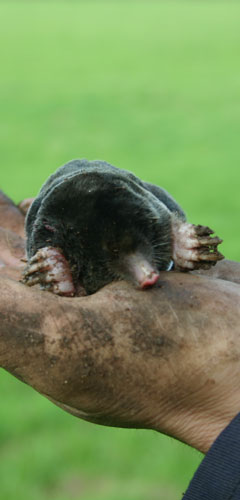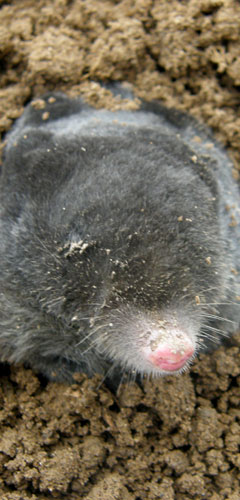- PEST PROBLEMS? CALL US NOW!
- 01865 362053 / 07802 485384
Pest Control for Moles
(Talpa Europaea)
 Mole control or mole removal, our professional mole catcher will ensure your moles are managed and damage to your lawn is kept to an absolute minimum. We know how to catch a mole and guarantee our mole control methods will deliver results.
Mole control or mole removal, our professional mole catcher will ensure your moles are managed and damage to your lawn is kept to an absolute minimum. We know how to catch a mole and guarantee our mole control methods will deliver results.
Here at Hawthorn mole control and removal is carried out by our professional, and highly experienced mole catcher. Not only will we catch and remove moles, we will also work with you to implement a mole control programme ensuring future activity is kept to an absolute minimum.
Many people would like to know how to catch a mole; our experienced mole catcher uses traps which are extremely effective. However, catching moles can be a tricky business requiring a lot of skill & experience, not to mention a little patience, so a professional mole catcher is always recommended to ensure the job is done right - first time - we will catch 'em, GUARANTEED!
The only mole species present in the UK is the European Mole. This creature is silver grey to black in colour, has a short tail which is covered in fur and weighs around 70 – 100g.
Moles are productive diggers and can create 20 metres of underground tunnel per day. It is often the mounds of earth that moles leave on our lawns and grassland, as they excavate their tunnels, that draws attention to them.
The mole has a well developed sense of smell, as all moles have a pair of scent glands beneath the skin which is connected to the ducts which discharges urine from the bladder. This enables moles to ‘mark’ their tunnels with a mixture of urine and sent. This also allows moles to identify occupied tunnel systems and, in the breeding season, the gender of the mole occupying the tunnel. Their strong sense of smell also enables them to detect unusual or unfamiliar smells which may be of danger to them. This can also cause the mole to block tunnels to avoid them.
The mole has sensory hairs or vibrissae which can be are found on and under the chin, on the muzzle, snout and in tufts on the sides of the face behind the ears. These hairs can also be found on the backs of the forefeet and on the tail. The sensory hairs on the muzzle and snout assist the mole to find food and probe tunnel walls. The mole holds its tail semi-erect and brushes against the tunnel walls and roof to pick up information, including vibrations passing through the soil.
The eyes of the mole are hidden under its fur, although both of their eyes are fully formed. However, as the moles habitat is predominantly underground, sight is of little use to them, although they can distinguish between light and dark.
The mole belongs to the mammalian order Insectivora, which means an animal that eats insects. Moles feed mainly on earthworms, although they also consume other soil invertebrates, particularly insect larvae and molluscs. The mole sleeps and feeds every 4 hours and they do not hibernate, which means that they are active throughout the year.
The mole inhabits deciduous woodland, grassland and farmland or wherever the soil is deep enough for them to tunnel. Moles are solitary creatures by nature and live for the majority of their life in the tunnelling system. The tunnelling system is made up of complex systems of permanent and semi-permanent tunnels.
The mole creates these tunnels using its spade-like forepaws. It uses alternate forepaws to dig tunnels, holding its body against the existing tunnel walls with its hind limbs and inactive forelimb. The soil is passed behind the mole’s body. Once a suitable amount of soil is accumulated, the mole turns in the tunnel and pushes the soil to the surface, creating either a new mole hill or contributing to an existing one.
The mole creates two types of tunnels, surface tunnels and deep tunnels. The surface tunnel is located just below the surface and is visible as a raised ridge of soil. These are short lived structures and not used permanently by the mole. Deep tunnels are the core tunnelling system used by the mole for both breeding and feeding.
The breeding season for the mole is February to June. The gestation period is 4 weeks, after which the young are born blind and furless. After 4 – 5 weeks, the young leaves the nest to start to catch food of their own. Shortly after this, the mole will depart the nest altogether and search for a home of their own. It is during this time that the mole can be seen above ground.
It is also important to note that although the mole is a solitary creature, moles do share main tunnels under hedges and fences, which means that their territories do overlap. This means that when a mole is removed or vacated from a tunnel, another mole will sense this and move in. However, the location of the tunnel will have a significant impact on whether a tunnel is re-occupied. There is no guarantee that once a mole is removed from an area the tunnel will not be re-occupied causing ongoing mole hill issues. However, ongoing management and control of moles will ensure that re-occupation and mole activity is kept at an absolute minimum.
Hawthorn Pest Control have extensive experience controlling moles both on residential grass and agricultural land. We work with many clients on an annual basis to ensure damage caused by moles is minimal. The best time to control moles is between October and April, although due to the varying climates over the past few years, we are finding that moles are visible for longer periods.
For further information on the methods we use to control Moles, please visit our Traditional Methods of Pest Control page.


